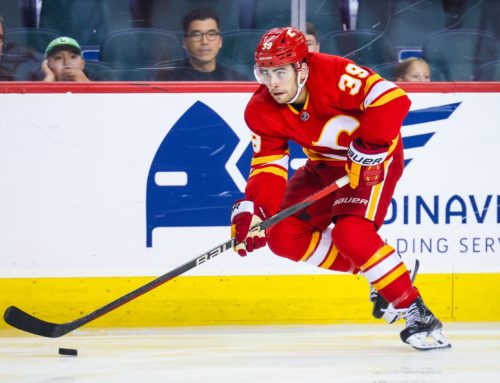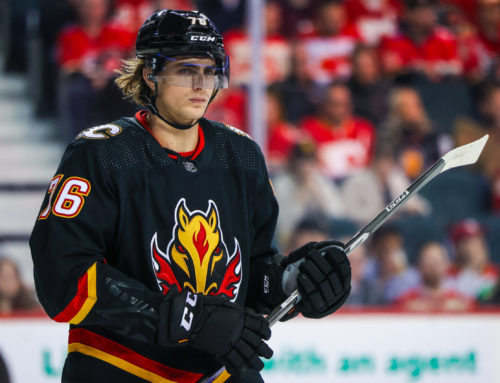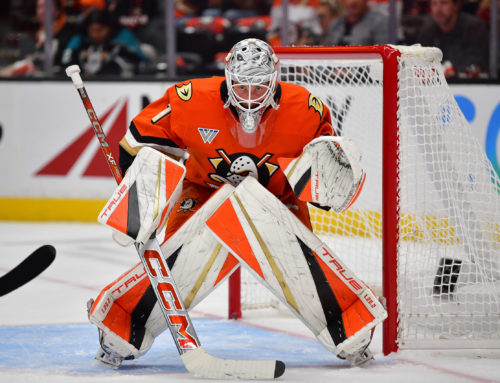
The Fantasy Hockey Geek is back for another season!
After a very enjoyable summer of watching some ball, catching some rays and indulging in a BEvERage or two, the Geek of the Week is back for the 2015-16 season. We will be providing in depth player profiles as usual, but with fantasy drafts right around the corner we thought it would be good to go back to school for this week with a little pre-draft Geek 101.
(For those who don’t already know: Fantasy Hockey Geek (FHG) is an online tool that uses various math and algorithms to determine the value of a player in your fantasy hockey league, given a certain statistic set. We all know that 50 points is better than 45 or that 18 PPP is better than 14, but what about a 50 point 14 PPP player vs a 45 point 18 PPP player? That’s where it gets difficult, but FHG does all that automatically across all your scoring categories in order to give you a single overall player value.)
Winning at the draft table comes down to following a few key principles and outsmarting the rest of your league and I have outlined these principles below. There are a lot of references to Fantasy Hockey Geek (FHG) here but these are principles that apply to everyone whether you use FHG or not. FHG just makes it a whole lot easier to implement the principles; and do so with extreme precision.
Position matters
A lot of managers out there understand that position matters but they still get it wrong anyways, and some managers don’t understand the value of position and they get it reeeeally wrong. The position a particular player is eligible matters to his value a lot. The thing is, in almost every fantasy hockey league you have the numbers of players per position defined for you (ie – 2 centres, 4 defence, etc. etc.) You obviously want to get output from all positions in a way that adds up to the best possible production for your team as a whole. How do you figure out how to do this though? If you assume that a 50 point D is the same as a 50 point C, you will be in big trouble at the end of your draft. Conceptually, the answer is that in the end it comes down to position scarcity.
Let’s assume that you’re in a 10-team league where you have to roster two centres and four defencemen. That means there will be 20 centres rostered and 40 defencemen. Now consider this: the Centre with the most points last season had 84. The 20th best Centre (the last rostered Centre) had 64. That’s a 20 point gap. Now looking at defencemen, the highest scoring D had 66 points while the last rostered D (40th) had 34. That’s a 30 point gap. The gap between the best D and the worst D is 50 percent higher than the gap between the best C and the worst C. This is important to consider when deciding what position to take. For simplicity sake think of it this way: If you were able to draft the best C but had to wait and ended up with the worst D, you would total 118 points in this scenario. On the other hand if you snagged the best D right off the top and were stuck with the worst C, your total would be 130. Leaving an 84 point C on the table to grab a 66 point D may have seemed counter intuitive at the time but in the end it was the right thing to do.
The example above is of course over-simplified but I just wanted to get one point across: grabbing the guy with the best stats isn’t always the way to go. Intuitively with points this is easy to grasp, but doing this systematically across all scoring categories is another thing entirely, and FHG automates that for you. So how can you determine whether a 66 point D really is more valuable than an 84 point C? That’s where FHG comes in. Take a look at some of the values FHG calculates based on actual data from the 2014-15 season (12 team Yahoo! H2H league measuring G, A, +/-, SOG, PPP, SHP, Hits):
|
Rank |
Player |
G |
A |
+/- |
SOG |
PPP |
SHP |
HITS |
|
12 |
11 |
43 |
12 |
197 |
24 |
1 |
131 |
|
|
13 |
25 |
48 |
-3 |
279 |
37 |
0 |
110 |
|
|
197 |
27 |
27 |
0 |
197 |
14 |
0 |
111 |
Kris Letang is a great fantasy asset which is reflected above: FHG calculates him as having had the 12th most value in this particular fantasy league last season. So as a 54 point defenseman, where does he rank compared to forwards? Claude Giroux, who scored 19 more points than Letang and had better output than Letang almost across the board actually provided the best comparable value as a forward. That may seem crazy to comprehend but the drop off between Letang and a replacement D is much greater than the drop off between Giroux and a replacement FWD in this league and the FHG math is showing that.
Now compare Letang to another forward who has very similar stats to him: Jarome Iginla. Iggy had 54 points just like Letang and also an identical 197 shots but Kris was ranked 185 spots ahead of Jarome! The reason for this is simple: in this league, 54 point forwards with about 200 shots are not hard to find but 54 point 200 shot defensemen are extremely scarce.
It is important to remember this principle at the draft table: pick the players that are hard to find/replace as opposed to automatically going for the player with the highest output. If you need help deciding exactly how to do this, run your league in FHG.
All leagues are not created equally
I always cringe when somebody asks the question “who is the best player in fantasy hockey”, because the reality is that the answer can be very different depending on what type of league you are in. The categories your league measures, the positions your league rosters and even the number of teams in your league can all impact how valuable a particular player is.
For example, Radko Gudas is essentially useless in a points-only league but in a league that counts hits and penalty minutes? Gudas is a beast. Far too many GMs draft on name and “feel” of how good a player is. Jonathan Toews is a better player than David Backes, so he often gets drafted ahead of Backes. But if your league counts hits and penalty minutes then drafting Toews first would be a grave error. Check out how FHG calculates the 2014-15 value of the two players in a league counting G, A, PPP, SOG, Hits, and PIM:
|
Rank |
Player |
G |
A |
PIM |
SOG |
PPP |
HITS |
|
11 |
26 |
32 |
104 |
183 |
16 |
227 |
|
|
71
📢 advertisement:
|
28 |
38 |
36 |
192 |
17 |
56 |
In this league, Backes was the 11th most valuable player last season while Toews was only the 71st most valuable. Now if we were to remove hits and penalty minutes? Take a look:
|
Rank |
Player |
G |
A |
SOG |
PPP |
|
66 |
28 |
38 |
192 |
17 |
|
|
94 |
26 |
32 |
183 |
16 |
Toews’ value only changed moderately as he would have been the 66th most valuable in this league but look at Backes- he dropped all the way to 94th overall. I took a really easy example here with Backes and I am sure that most of you would know enough to bump Backes up your draft board in a league that counts hits and penalty minutes – but would you know how high to bump him up? Would you know what to do with Travis Hamonic? Would you know how much including penalty minutes hurts Phil Kessel? You may or may not and FHG can help you with that math. The principle is important to remember though: the settings in your particular league matter a lot and you need to consider the impact on each players’ value.
All categories are worth the same amount
A common mistake GMs make in roto style head to head leagues is putting an over emphasis on goals and assists. We are all conditioned to value players based on their offensive output and there is some merit to this, but the reality is this: If you win the goals and assists categories on a given week but lose power-play points, shots on goal, and hits, then you lose your matchup. GMs (particularly newer GMs) tend to drastically undervalue the peripheral stats. This is why Jordan Eberle has an Average Draft Position (ADP) of 35th overall while Gabriel Landeskog is way down at 54th overall. A novice GM might look at Eberle’s 63 points last season (and upside for more) compared to Landeskog’s 59 and conclude that it makes sense that Eberle is being drafted earlier. Look at how FHG calculates their values though:
|
Rank |
Player |
G |
A |
+/- |
SOG |
PPP |
SHP |
HITS |
|
66 |
23 |
36 |
-2 |
214 |
17 |
0 |
169 |
|
|
193 |
24 |
39 |
-16 |
183 |
21 |
0 |
62 |
In this league, Landeskog is a far superior player than Eberle because Landeskog dominates in almost all categories, despite the fact that Eberle gets a couple more points. The comparison of these two players perfectly exemplifies the need to understand the value of peripheral stats: Eberle scored four more points than Landeskog but was valued 127 slots lower last season because of his poor peripherals. A key drafting principle is to remember to place enough value on the peripheral stats – don’t get blinded by points. If you need help deciding just how much certain peripherals are worth in terms of player value in your league, put your league in FHG and let them do the math for you.
Understand ADP. Understand the draft room.
The principles I have laid out above and the use of a tool like Fantasy Hockey Geek are absolutely paramount to understanding player value and crafting your draft strategy. This is the science behind the draft and it is the backbone to your success. A draft is both a science and an art though and you need to understand Average Draft Position (ADP) as well as the draft room that you are in. This is how it all comes together.
The ADPs are usually readily available on whatever site provider you use. A great strategy to use is to compare the ADPs of a player to where you have them ranked (based on the principles above and FHG input). This can help you to determine when to pick a player. FHG may have told you that Kris Letang was the 11th best player in your league this year, but that doesn’t mean you have to pick him at 11 – his ADP is 53rd. If you could get Letang around 35th overall it would be a steal and you would still likely be able to land him before others were considering taking him.
ADP alone isn’t enough though; you have to know your room. If you have more shrewd managers in a more unique league, then they are also likely to know to pick Letang earlier than 53rd. You have to understand these things and use them to your advantage. As a fantasy hockey GM, these are the kind of things I spend my time considering and strategizing about. I let FHG do the math work for me so that I can get my player values and then I use that as a weapon as I craft my draft strategy. This is the most exciting part of fantasy hockey, it’s what we all prepare for.
Good luck to all at your upcoming drafts. Hopefully some of the strategies I have outlined here combined with the amazing tools at Fantasy Hockey Geek will help to get you back to basics and provide a good foundation and understanding of value going into your drafts. Looking forward to another season of finding value and contributing to championships!
5 Comments
Leave A Comment
You must be logged in to post a comment.





 WSH
WSH CAR
CAR WPG
WPG DAL
DAL TOR
TOR DET
DET MIN
MIN EDM
EDM VGK
VGK FLA
FLA

Hi Terry, I've noticed that RW-only eligible players in FHG tend to be ranked considerably lower than any other position. Trying to figure out why? For example if a RW had comparable or sometimes better stats across the board than a C, the C would still come out ahead in FHG ranking. I inputted G, A, P, PPP, PIM and it has Turris (C) ranked ahead of Tarasenko (RW). Is C really more scarce than RW?
That doesn't seem right to me. RW is more scarce than C. What is your league setup? (number of teams, how many of each position rostered and categories). Also what data set? (last years actuals?) I will take a look if you let me know
ALso check the settings and make sure you have "more is good" clicked on each of the categories that your league counts. I can't see Turris being ahead of Tarasenko in almost any league set up.
Using last year's actuals.
12 teams – 2 C, 2 LW, 2 RW, 3 D, 1 Util. Categories used are G, A, P, PPP, PIM.
"more is good" is selected for all of the 5 categories.
Okay I think I figured it out. I removed the 1 Util spot and re-ran the rankings and Tarasenko is now ahead of Turris. Could you maybe comment on the effect of the Util spot? Any idea why having a Util spot would propel Turris (C) over Tarasenko (RW)?
Hi Terry, does the FHG value take into account games played limits per roster spot?
When i first created my league in FHG with 82 GP limit per roster spot, the goales have a really high FHG value (Luongo had a higher value than Stamkos) but today when I checked my rankings the goalies had much lower FHG values (Luongo now has the same FHG value as Vatanen). Not sure what to make of all this now